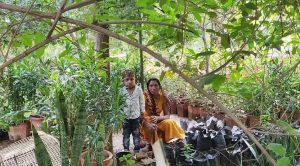Thinking Beyond Immediate Outcomes of Financial Inclusion

Photo by Visually Engaged
Entrepreneurship rests on initiative. Initiative beckons action, actions produce outcomes, and outcomes, including failure, often signify the way forward. A popular entrepreneurial motto is ‘Don’t just think, ACT!’ Endless loops of creative thinking may lead nowhere. Action is necessary — entrepreneurs believe.
However, in a bid to move first, act fast, couldn’t one turn into that carpenter who merely asks, “Which tools?”, but forgets to ponder, “Why build?”
As researchers with the Bharat Inclusion Initiative, our objective is to identify gaps and opportunities for innovation and entrepreneurial pursuits towards financial inclusion of the underserved in India. As part of the Initiative, from the very beginning, however, we felt the need to develop a perspective on the “Why build?”, so that we may, in due course, avoid the perils of aimless carpentry.
Hence, compulsively argumentative as any professional researcher is, we attempted to closely evaluate the very premise of our objective. We asked simple questions. ‘Why financial inclusion? Why is access to financial products and services important for low and middle income groups?’ We also asked slightly complex questions- what is the long term impact of financial inclusion? How exactly does access to financial products and services transform the lives of low-and-middle-income communities?
Answers to the first couple of questions were easy to come by. A significant body of literature affirms that access to financial products and services yield positive financial outcomes for the poor and the underserved. Broadly speaking, the mandate for financial inclusion covers access to four major types of financial products/services- savings, credit, insurance and payment services. Together, these products/services can help low income households manage cash flows, save and cope with risk.
There is considerable evidence (largely from the African context) in support of this. For instance, a 2013 study in rural Kenya found that access to a formal savings services helped female market vendors smoothen expenditure on food and build working capital for their businesses[i]. Similarly, Tavleen Suri’s study on the impact of mobile money services in Kenya concluded that access to a mobile based remittance service caused increase in per capita consumption and lifted nearly 2 percent of Kenyan households out of extreme poverty[ii]. Further, access to insurance products among subsistence farmers in Ghana was found to encourage greater investments in cultivation and riskier production choices; which translated to higher incomes[iii].
The question one asks at this point however, is- where do these outcomes eventually lead? Are these in themselves the end of financial inclusion? From what we have read, it appears that such may not be the case.
Access to finance has the potential to generate welfare outcomes beyond financial benefits. Let us look at two studies that have been able to map such transformations. A study by Ashraf, Karlan and Yin (2010) analysed the impact of a commitment savings product offered to women in Mindanao in Philippines[iv]. It found that access to the product had a positive effect on intra-household decision-making power of women around variables like use of money, schooling of children and use of family planning.
A similar study was carried out in 19 slums around Pokhara in Nepal. Researchers found that girl children from households that were offered savings accounts were more likely to complete more years of schooling. The study also observed that parents from such households were more likely to aspire for a higher level of education for their children. The study hypothesised that greater control (or perception of control) over their financial lives freed cognitive reserves among women in the sample households, allowing them to focus on their daughters’ current and future education[v].
Insights such as these indicate to us the end goals of financial inclusion. They therefore, suggest to us that interventions of financial inclusion have the potential to impact outcomes beyond augmentation of income and wealth. They also emphasize that such interventions would do better by taking a more extended view and propose solutions that augment the competence and decision making abilities of users, which would thereby render better health, education, gender equity, public participation etc.
Now, this is obviously easier said than done. For one, the causal relationships linking access to financial products/services to improvements in higher level indicators of welfare are not understood very well. Evidence is sparse as well as mixed. Secondly, most research in the area has relied on Randomised Control Trials (RCT), the results of which are rarely generalizable unless supported by frequent replication[vi]. In addition, majority of RCTs have studied effects of singular products, which again is problematic. This is so because, as Collins and Ng’weno argue, a product-by-product tracking of impact impedes holistic analysis[vii]. Access to financial products/services have ‘interwoven effects on people’s lives’. Moreover, the impact of one service/product may interact with or amplify the potential of another in a suit of financial products/services. It is only when these multiple impact pathways are isolated that one can identify mechanisms of broaching various welfare targets.
All of this calls for the development of rigorous new frameworks for impact tracking and for the collaborative revisiting of motivations underlying entrepreneurial interventions in the financial inclusion space. These interventions have the potential to create long-term, sustained, multi-faceted, desirable impact for the low and middle income segment. Findings from various geographies suggest that it helps to see financial inclusion as an enabler to a variety of outcomes. Perhaps it may serve the cause not to see financial inclusion as an end.
And it is with these preliminary thoughts that we hope to proceed with our objective. Stay with us as we explore and experiment with possibilities. Do share your thoughts and experiences with us. We would love to start a conversation!
References
[i] Dupas, P., & Robinson, J. (2013). Savings Constraints and Microenterprise Development: Evidence from a Field Experiment in Kenya. American Economic Journal- Applied Economics, 5(1).
[ii] See Suri, T., & Jack, W. (2016, Dec 9). The long run poverty and gender impacts of mobile money. Science, 354(6317). Retrieved from news.mit.edu.
[iii] Karlan, D. et al (2014). Agricultural Decisions after Relaxing Credit and Risk Constraints. Quarterly Journal of Economics, 129(2).
[iv] Ashraf, N., Karlan, D., & Yin, W. (2009). Female Empowerment: Impact of a Commitment Savings Product in the Philippines. World Development, 38(3).
[v] Chiapa, C., Prina, S., & Parker, A. (2014). The Effects of Financial Inclusion Beyond Financial Outcomes.
[vi] See for e.g. Karlan, D., & Morduch, J. (n.d.). Access to Finance. In D. Rodrik, & M. Rosenzweig (Eds.), Handbook of Development Economics (Vol. 5) and Singh, N. (2017). Financial Inclusion: Concepts, Issues and Policies for India. International Growth Centre.
[vii] Collins, D., & Ng’weno, A. (2018, Jan). Do Financial Inclusion Efforts Really Have an Impact on Poverty. Retrieved from ssir.org: https://ssir.org/articles/entry/do_financial_inclusion_efforts_impact_poverty
